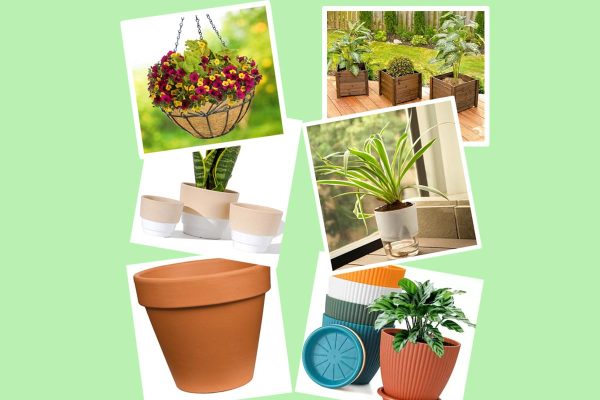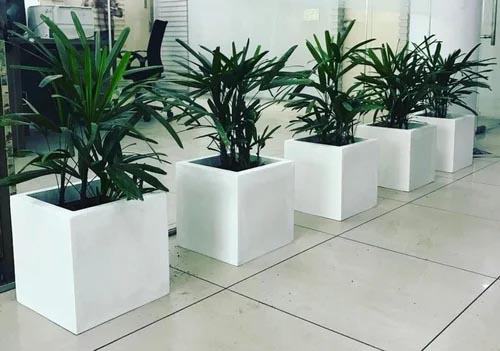
Exploring Garden Containers: A Guide to Types, Pros, and Cons
Pots serve as homes for plants, nurturing their growth and providing a controlled environment. Constructed from Cement, Metal, or Plastic, these containers come in diverse colours, sizes, and designs. Planting in containers or pots allows you to adorn your garden, balcony, or indoor spaces. It offers a practical solution for those with limited planting space or wanting to integrate nature into their homes.
Whether adorning your garden with vibrant flowers, cultivating a balcony herb garden, or bringing the freshness of vegetables and fruits indoors, these containers are versatile and cater to various preferences. Embracing container gardening is an excellent way to unleash your creativity while enjoying the beauty and benefits of nature in even the most confined spaces.
When it comes to gardening, the choice of containers can significantly impact the success and aesthetics of your green space. Each type has unique advantages and drawbacks, from traditional terra cotta pots to innovative self-watering planters. In this guide, we’ll delve into various garden containers, exploring their pros and cons to help you make an informed decision for your flourishing garden.

Terra Cotta Pots
With their rustic charm and timeless appeal, Terra cotta pots have been a staple in gardening for centuries. Crafted from Clay, these classic containers offer a porous and breathable environment for plant roots. In this exploration, we delve into the enduring allure and practical advantages of terra cotta pots in gardening.

Pros:
Classic and timeless appearance, allows proper airflow to roots, affordable.
Cons:
Can dry out quickly, prone to cracking in freezing temperatures, heavier than alternative materials.
Also Read This : Year-Round Harvest: 10 Versatile Vegetables for Your Home Garden
Plastic Containers
Plastic containers have become a staple in gardening, offering versatility and practicality. Lightweight and affordable, they come in various shapes and sizes, making them ideal for multiple plants. Plastic containers remain famous for gardeners seeking convenience and a cost-effective planting solution despite potential degradation over time.

Pros:
Lightweight, affordable, available in various sizes and colours, retains moisture well.
Cons:
May degrade over time due to UV exposure and may not insulate roots in extreme temperatures.
Also Read This : Blooming Brilliance: Cultivating Vibrant Bougainvillea from Cuttings
Wooden Planters
Wooden planters seamlessly blend natural charm with functionality, providing an appealing home for your favourite plants. These versatile containers add a rustic touch to any garden or patio. From enhancing curb appeal to creating a personalized herb garden, wooden planters are a stylish and practical choice for plant enthusiasts.

Pros:
Natural look, sound insulation for roots, customizable and versatile.
Cons:
Prone to rot over time, may require periodic sealing or painting and can be heavier than plastic.
Also Read This : 13 Mesmerizing Flowering Succulents: A Blooming Garden Delight
Ceramic or Glazed Containers
Ceramic or glazed containers bring a touch of sophistication and elegance to your garden. With their stylish appearance and durable construction, these containers serve as functional homes for plants and elevate the aesthetic appeal of any space. Explore the beauty and versatility of ceramic or glazed containers for a garden that reflects your unique style.

Pros:
Stylish and decorative, retains moisture, durable.
Cons:
Heavier than other options, may be more expensive and can crack in freezing temperatures.
Also Read This : Spring: Nature’s Perfect Season for Plant Growth
Metal Planters
Metal planters bring a sleek and modern touch to your garden or indoor spaces. Crafted from durable materials, these containers offer a contemporary aesthetic while providing a sturdy home for your plants. With various designs and sizes available, metal planters are stylish and functional additions to any green space.

Pros:
Sleek and modern appearance, durable, lightweight.
Cons:
It may heat up quickly in direct sunlight, rust over time, and not insulate roots well in extreme temperatures.
Also Read This : Bottom-Watering: A Friendlier Approach to Potted Plant Care
Self-Watering Planters
Self-watering planters revolutionize gardening by providing a convenient solution for busy plant enthusiasts. These innovative containers feature a built-in reservoir that ensures plants receive a consistent water supply, reducing the need for frequent watering. For indoor and outdoor spaces, self-watering planters simplify plant care, making it accessible.

Pros:
Convenient, reduce watering frequency, maintain consistent moisture levels.
Cons:
Initial cost may be higher, heavier due to the water reservoir, and requires occasional maintenance.
Also Read This : Thriving in Minimal: 7 Indoor Plants That Excel in Low-Nutrient Soil
Fibreglass Containers
Fiberglass containers have become popular in modern gardening, offering a lightweight and durable alternative for plant enthusiasts. With versatility in design and the ability to mimic the appearance of other materials, fibreglass planters provide an attractive and practical solution for enhancing indoor and outdoor spaces.

Pros:
Lightweight, durable, can mimic the look of other materials, frost-resistant.
Cons:
It may be more expensive, with limited styles than other materials.
Also Read This : Homegrown Happiness: Tips and Tricks for Thriving Strawberry Plants
Hanging Baskets
Hanging baskets are the perfect fusion of elegance and space efficiency in gardening. Suspended from Hooks or Structures, these baskets transform unused vertical space into lush displays of flowers or cascading greenery. Ideal for both outdoor and indoor spaces, hanging baskets add a touch of botanical charm, elevating any environment with their versatile beauty.

Pros:
Utilizes vertical space, decorative, suitable for trailing plants.
Cons:
Requires secure hanging support, may dry out more quickly, limited in size.
Also Read This : Growing Brinjal (Eggplant) at Home: A Comprehensive Guide for a Bountiful Harvest
Choosing a suitable garden container involves considering your specific needs, the type of plants you want to grow, and your aesthetic preferences. By understanding the pros and cons of various containers, you can make an informed decision that complements your garden design and provides an optimal environment for your plants to thrive. Whether you opt for the timeless charm of terra cotta or the modern convenience of self-watering planters, the key is to strike a balance that aligns with your gardening goals and preferences.




